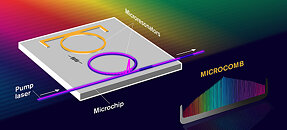TheLostSwede
News Editor
- Joined
- Nov 11, 2004
- Messages
- 17,942 (2.44/day)
- Location
- Sweden
| System Name | Overlord Mk MLI |
|---|---|
| Processor | AMD Ryzen 7 7800X3D |
| Motherboard | Gigabyte X670E Aorus Master |
| Cooling | Noctua NH-D15 SE with offsets |
| Memory | 32GB Team T-Create Expert DDR5 6000 MHz @ CL30-34-34-68 |
| Video Card(s) | Gainward GeForce RTX 4080 Phantom GS |
| Storage | 1TB Solidigm P44 Pro, 2 TB Corsair MP600 Pro, 2TB Kingston KC3000 |
| Display(s) | Acer XV272K LVbmiipruzx 4K@160Hz |
| Case | Fractal Design Torrent Compact |
| Audio Device(s) | Corsair Virtuoso SE |
| Power Supply | be quiet! Pure Power 12 M 850 W |
| Mouse | Logitech G502 Lightspeed |
| Keyboard | Corsair K70 Max |
| Software | Windows 10 Pro |
| Benchmark Scores | https://valid.x86.fr/yfsd9w |
Transmitting data over the internet is something that just happens for most of us, but the infrastructure that's powering the internet is full of bottlenecks and researchers around the world are testing new ways of being able to transmit more data using already installed fibre. A team of researchers from the Technical University of Denmark (DTU) has managed to break the data transmission record by quite some margin, using something called a frequency comb, which is a photonics chip. The team of researchers hit a data transmission speed of an insane 1.84 Petabits per second over a distance of 7.9 kilometres—or 4.9 miles if you like—using standard fibre optic lines.
This equates to more than the total volume of global internet traffic that's being sent every second, according to DTU. Although the distance is far from the longest, as a team of Japanese researchers have managed to transmit a 319 Terrabit per second datastream over a distance of 3,001 km (1,864 miles), although they used signal amplifiers every 70 km to reach this distance. The DTU team's frequency comb was made by Chalmers University of Technology in Sweden and it breaks down the infrared laser that's being used to transmit the data, into a rainbow spectrum, where each colour corresponds to a frequency equivalent. This allows multiple streams of data to be encoded with data, before being re-integrated and sent as a single infrared laser signal over the fibre. According to DTU, without the frequency comb, they would've needed more than a thousand lasers to achieve the same speeds using state-of-the-art commercial equipment. The team at DTU expects to be able to hit speeds of up to 100 Petabit per second in the future.

View at TechPowerUp Main Site | Source
This equates to more than the total volume of global internet traffic that's being sent every second, according to DTU. Although the distance is far from the longest, as a team of Japanese researchers have managed to transmit a 319 Terrabit per second datastream over a distance of 3,001 km (1,864 miles), although they used signal amplifiers every 70 km to reach this distance. The DTU team's frequency comb was made by Chalmers University of Technology in Sweden and it breaks down the infrared laser that's being used to transmit the data, into a rainbow spectrum, where each colour corresponds to a frequency equivalent. This allows multiple streams of data to be encoded with data, before being re-integrated and sent as a single infrared laser signal over the fibre. According to DTU, without the frequency comb, they would've needed more than a thousand lasers to achieve the same speeds using state-of-the-art commercial equipment. The team at DTU expects to be able to hit speeds of up to 100 Petabit per second in the future.

View at TechPowerUp Main Site | Source






